Category: Amy’s Animals Family
The Magical Properties of Mushrooms..more than just a pizza topping!
 When most people think of mushrooms the first thing that comes to mind are either the tasteless white button variety they see at every salad bar they’ve been to or the hallucinogenic variety also known as “magic mushrooms”. Fungi have been on the planet for hundreds of millions of years longer than the plant or animal kingdom. They are one of the most versatile of all living organisms. Many people don’t realize that the mushrooms you see and eat are actually the fruit of the hidden below the surface, mycelium.
When most people think of mushrooms the first thing that comes to mind are either the tasteless white button variety they see at every salad bar they’ve been to or the hallucinogenic variety also known as “magic mushrooms”. Fungi have been on the planet for hundreds of millions of years longer than the plant or animal kingdom. They are one of the most versatile of all living organisms. Many people don’t realize that the mushrooms you see and eat are actually the fruit of the hidden below the surface, mycelium.
The purpose of the mushroom or “fruit” is to mature and produce spores, much like a flower blooms and produces seeds. Mushrooms and mammals share many of the same characteristics. We both require outside food sources. We both breathe in oxygen and breathe out carbon dioxide and water. Since we share the same types of needs to support life, we are able to take advantage of the many compounds the mushrooms manufacture to protect themselves in survival from pathogenic organisms such as bacteria, viruses & molds. Our mammalian bodies can utilize these helpful compounds very efficiently. Mushrooms have been utilized in medicinal applications for thousands of years. Many types of mushrooms have immune-boosting or immune regulating capabilities. Their role in treatment for auto-immune disorders has proven to be very beneficial. They are also used in the prevention, treatment and cure of multiple types of cancer. Turkey Tail mushroom in particular, is used to reduce nausea and other forms of side effects from chemotherapy and it also is used to keep white blood cell counts higher. Their use in fighting cancer is remarkable.
types of needs to support life, we are able to take advantage of the many compounds the mushrooms manufacture to protect themselves in survival from pathogenic organisms such as bacteria, viruses & molds. Our mammalian bodies can utilize these helpful compounds very efficiently. Mushrooms have been utilized in medicinal applications for thousands of years. Many types of mushrooms have immune-boosting or immune regulating capabilities. Their role in treatment for auto-immune disorders has proven to be very beneficial. They are also used in the prevention, treatment and cure of multiple types of cancer. Turkey Tail mushroom in particular, is used to reduce nausea and other forms of side effects from chemotherapy and it also is used to keep white blood cell counts higher. Their use in fighting cancer is remarkable.
The use of mushrooms in medical science has been documented for thousands of years. Their application for various ailments such as central nervous system disorders, wound healing & blood circulation stimulation has also been successfully tested and documented. One of the more fascinating applications has been the use of mushrooms in environmental remediation. Their use to filter toxins out of run off from factory farming operations has proven to be extremely efficient and environmentally beneficial.
One always has to use caution when dealing with mushrooms though. Even though many are extremely beneficial, there are mushrooms out there that can also prove deadly. If you are not sure of the type of mushroom, it is better left to the experts. To take advantage of all the fantastic medicinal benefits of mushrooms, you don’t have to have a degree in Mycology. There are many great companies such as Mushroom Matrix and Aloha Pharmaceuticals that produce mushroom extract powders for humans and pets. They are easy to use and will provide all the benefits you are looking for.
So next time you see a mushroom pop up in your yard, take a closer look and marvel at all the magical goodness that lurks inside!
Dastardly Doggy Breath
 There’s nothing worse than bending down for doggie kisses and instead getting a faceful of stinky breath! What ever happened to that sweet clean breath and those pearly white teeth? That nasty smell can be an indicator of an underlying health problem, loose teeth or the build up of plaque and tarter. There are some common misconceptions as to what causes poor dental health and also about how to maintain good dental health.
There’s nothing worse than bending down for doggie kisses and instead getting a faceful of stinky breath! What ever happened to that sweet clean breath and those pearly white teeth? That nasty smell can be an indicator of an underlying health problem, loose teeth or the build up of plaque and tarter. There are some common misconceptions as to what causes poor dental health and also about how to maintain good dental health.
Domesticated dogs have a much different lifestyle and diet than their wild ancestors. Our dogs of today are usually fed diets that contain grains and starches. These components alone have the potential to cause dental disease. Grains and the gluten they contain coat the teeth with the building blocks of plaque. As more of these grains and starches are ingested, more plaque and tarter form. Bacteria also thrive in the environment created by these dietary inclusions. One of the common misconceptions dog owners have is that dry kibble diets and biscuits given as treats will help to remove these deposits. This can’t be further from the truth! If grains and starched removed plaque and tarter, we would be brushing our teeth with crackers!
When fed a species appropriate diet, like raw meat diets, the enzymes in the mouth change into an environment that does not support the buildup or the bacteria. Also, when dogs are given the opportunity to chew on harder bones such as femur bones, the edges of the bone rub against the surface of the tooth to remove any buildup. Bones are nature’s toothbrushes! If you have a dog that doesn’t like to chew hard bones, there are other alternatives too. Brushing your dog’s teeth on a regular basis will also help to keep his mouth healthy.
If your dog won’t tolerate brushing, there are now natural dental sprays that will do the job for you. The sprays also kill any bacteria that would cause gingivitis. Another alternative is a kelp based food additive that changes the enzymes in the mouth to help prevent the buildup and the bacterial growth.
Since there are many ways to keep that “doggy breath” under control, there is no reason not to get down and let the kissing begin!!
Until next time my Furry Followers!
Canine Vaccinations..Debunking the Myths, Reporting the Facts
 One of the most misunderstood subjects in the world of dog ownership has to be that of vaccinations. Most pet owners rely on their veterinarians to provide the information needed to make the correct decision in regards to this very important subject.
One of the most misunderstood subjects in the world of dog ownership has to be that of vaccinations. Most pet owners rely on their veterinarians to provide the information needed to make the correct decision in regards to this very important subject.
Unfortunately, according to immunology expert Dr. Ronald Shultz DVM, veterinary students are not given a complete education in immunology. The information they are given in college is provided by the vaccine manufacturers. You would think that since the manufacturers are providing the information that it would be the most thorough, accurate information available on that particular vaccine, and it is, to a point.
The one area that is usually not divulged at length is the instance of adverse reactions and other health related concerns that have been attributed to these vaccines. Most conventional veterinarians in the United States follow a yearly vaccination protocol. Their offices send out reminder cards in the mail to remind pet owners of the need to vaccinate their pet. The vaccines that are routinely “boosted” yearly are typically vaccines for Parvovirus, Distemper and Adenovirus. Some veterinarians use what we call “combo-whombo” vaccines that not only contain the typical three, but also have other vectors included such as coronavirus and leptospirosis.
Vaccinations are broken down into two groups, core vaccines and non-core vaccines. The core vaccines, Parvo, Distemper and Adenovirus, are the ones that are recommended for the general pet population. The non-core vaccines such as, Leptospirosis, Coronavirus and Lyme, are only recommended in certain instances where, geographically, your pet might be exposed to a certain vector that is not found in other areas. Non core vaccines usually only have a duration of one year or less. Dr. Shultz does not recommend using Leptospirosis vaccine on any small or toy breeds because of the high instance of serious adverse effects in those dogs.
The Lyme disease vaccine is only 50-60% effective, so this too is really not recommended until the vaccine company improves its efficacy. Coronavirus is not found in our area, the northeast, so that is also not recommended. Any of the vaccines, core or non-core, are not mandatory vaccines. The only vaccine that is mandatory, by law, is the Rabies vaccine which is given every three years.
The main thing that all pet parents need to realize is that vaccines do not come without risk. Whenever anything is injected into the body there is a risk of that vector causing an adverse reaction. This is especially prudent when you are introducing a foreign material that is meant to directly stimulate an immune response. The adverse reactions caused by vaccines can be as profound as having the animal die immediately after administration or they can be as subtleas the animal displaying symptoms such as lethargy, loss of appetite, hair loss, & itching. These more subtle reactions are usually seen from minutes after vaccination to months after vaccination. Since some of them don’t materialize until weeks or months later, they are usually contributed to “allergies” when presented to the veterinarian.
What every pet parent has to know is that the core vaccines have been proven to last a lifetime for most animals. As long as they are given at the correct intervals initially, the animal does not need to get “booster” shots at any time after the initial series of shots. The best way to tell if your pet is immunized and protected by the vaccinations is to have a titer test done. Titer testing is a simple procedure where your veterinarian will draw some blood and send it out to the lab to measure the antibody levels present in the blood sample. As long as there are antibodies present, your pet does not need any more shots. The  antibody level does not go down over the course of the animals life.
antibody level does not go down over the course of the animals life.
Although there is no need, for any pet owners that want to re-check the antibody levels, instead of taking your pet for “booster” vaccinations you can take him for a re-check of the antibody levels periodically throughout your pet’s life. By titering instead of over vaccinating, you can be assured that you are providing the correct care to help keep your pet happy and healthy for years to come. As Dr. Schultz says “Vaccinate but vaccinate Wisely!”
Until next time my furry followers!
Hacking up Hairballs
 One of the most common complaints I hear from cat owners is that their cat is constantly throwing up. It is so common that ” hacking up a hairball” has become a known euphemism. There are many reasons why some cats vomit on a regular basis.
One of the most common complaints I hear from cat owners is that their cat is constantly throwing up. It is so common that ” hacking up a hairball” has become a known euphemism. There are many reasons why some cats vomit on a regular basis.
There are some medical conditions that cause nausea and vomiting. Kidney disease is one of them. If the cat is starting to have a decline in kidney function, one of the signs is anorexia and vomiting. If these symptoms have been observed for more than a couple of days a veterinary visit is definitely advised.
Another medical cause for frequent vomiting is sometimes cancer. This is usually accompanied by anorexia, weight loss and lethargy. If these symptoms are observed for more than a couple of days, this too would warrant a veterinary visit. These are, of course, extreme accounts and typically not the 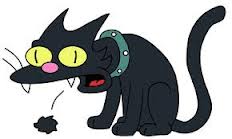 norm.
norm.
In my experience, the most likely reason for most cats is the diet they are being fed. Most cat owners feed their cats a dry kibbled diet that is left out in the bowl so the cat can pick on it all day. Since cats are obligate carnivores, they have no nutritional requirement for carbohydrates. When cats are fed a diet consisting of a high carbohydrate level, which are also typically high in “filler” ingredients, their bodies reject the food because they do not produce the enzymes necessary to digest that type of product. Another problem with dry kibbled foods is the lack of moisture in them. Cats need moisture in their food to help them to properly digest it. Indoor cats that spend a lot of time grooming also have the tendency to throw up, especially when they are fed too many carbohydrates. The carbohydrates alkalize the stomach acid which, in turn, helps to create hairballs. Cats that are fed an all meat diet have stomach acid that is corrosive enough to break down the hair before it gets into the small intestine, thereby, preventing hairballs.
If any cat parent wants to alleviate the problem of their cat constantly throwing up, the simple solution is to change the cat’s diet to, ideally, a raw food diet. 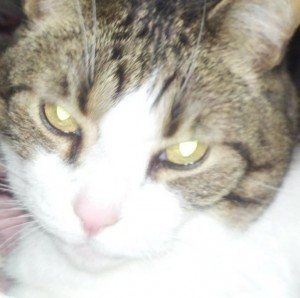 If there is a reason a raw food diet is not appropriate, a dehydrated (but rehydrated) or grain free canned food is the next best choice. By feeding a diet that most closely resembles the food a cat has evolved to eat, you will eliminate the problem of your cat “hacking up a hairball”!
If there is a reason a raw food diet is not appropriate, a dehydrated (but rehydrated) or grain free canned food is the next best choice. By feeding a diet that most closely resembles the food a cat has evolved to eat, you will eliminate the problem of your cat “hacking up a hairball”!
Until next time my faithful furry follower!
Canine Obesity
 Obesity rates in humans have reached alarming levels. It is estimated that 64% of U.S adults are overweight or obese. Our canine friends are not far behind. The estimates for dogs are 25-40% and climbing. Lifestyles have been changed with the advances in electronic technology. Time that used to be spent outdoors is now spent indoors in a “virtual” reality. Most dogs are forced to rely on 1 hour or less of vigorous exercise a day. Many spend hours locked in crates while their owners are at work. This lack of exercise for both humans and our furry companions plays a big part in the obesity problem.
Obesity rates in humans have reached alarming levels. It is estimated that 64% of U.S adults are overweight or obese. Our canine friends are not far behind. The estimates for dogs are 25-40% and climbing. Lifestyles have been changed with the advances in electronic technology. Time that used to be spent outdoors is now spent indoors in a “virtual” reality. Most dogs are forced to rely on 1 hour or less of vigorous exercise a day. Many spend hours locked in crates while their owners are at work. This lack of exercise for both humans and our furry companions plays a big part in the obesity problem.
Poor diet is another major contributing factor. Poor quality food, weather it is for humans or dogs, is all considered “fast food”. Many people equate food with love. We all feel good if we can feed something. Petting zoos are successful because people have the “need to feed”. People that over feed their dogs are, literally, killing their dog’s with kindness. Unless someone points this out to them, most people don’t recognize the problem until serious health issues arise.
Testing can be done to rule out any possible medical reasons for the weight gain such as a thyroid condition. If all medical conditions are ruled out, the most common causes are: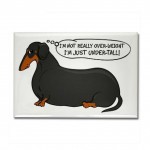
- High Carbohydrate Diet-Usually corn based
- TREATS-TREATS-TREATS
- Lack of Exercise
Lets address these common causes one by one.
1. Carbohydrates are poorly utilized by the dog. All the extra energy from those carbohydrates is stored as fat. High carbohydrate foods are considered the “fast foods” of the dog food market. A better alternative is a high protein, low carbohydrate, reduced fat diet. They are available in kibbled, canned, dehydrated or frozen raw formulas. The volume of the dog’s ration should also be reduced. To make the dog feel fuller, vegetables such as green beans and canned pumpkin can be added to make the dog feel satisfied without adding extra calories. Veterinary formulas that are prescribed for overweight dogs are usually low fat, high fiber formulas. They are not recommended for long term use because of the low quality of their ingredients.
2. Treat Limits – Many people over-treat their dogs. Instead of being rewarded for DOING something, dogs are treated for just BEING. It becomes a routine for people to treat the dog at certain times throughout the day. The dog becomes conditioned to receive the treats and will harass the owner or stare at the area the treats are kept. Fortunately,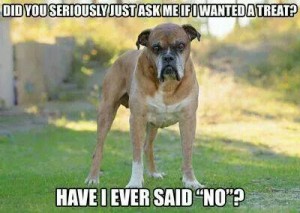 dogs can be conditioned into and out of anything. The hard part is changing the owner. One large wheat based biscuit contains 500 calories. One small wheat based biscuit is equivalent to 1 hamburger for 20lb dog. That is a meals worth of calories. Eventually it is going to catch up! The treats don’t have to be eliminated completely, but can be limited in quantity and changed to a treat that is better for the dog. Carbohydrate based treats such as biscuits should be substituted with meat based treats or real meat. Freeze dried chicken breast is an easy, low calorie, treat. Real meat can be cut into small cubes and frozen individually on a cookie sheet. They can be kept in a bag in the freezer to be used at any time. Frozen vegetables such as green beans, peas or broccoli make great low calorie treats as well. Fresh or frozen asparagus spears are a great chew stick for little dogs. They love them and they are good for them.
dogs can be conditioned into and out of anything. The hard part is changing the owner. One large wheat based biscuit contains 500 calories. One small wheat based biscuit is equivalent to 1 hamburger for 20lb dog. That is a meals worth of calories. Eventually it is going to catch up! The treats don’t have to be eliminated completely, but can be limited in quantity and changed to a treat that is better for the dog. Carbohydrate based treats such as biscuits should be substituted with meat based treats or real meat. Freeze dried chicken breast is an easy, low calorie, treat. Real meat can be cut into small cubes and frozen individually on a cookie sheet. They can be kept in a bag in the freezer to be used at any time. Frozen vegetables such as green beans, peas or broccoli make great low calorie treats as well. Fresh or frozen asparagus spears are a great chew stick for little dogs. They love them and they are good for them.
3. Exercise – This is by far the hardest part of the weight loss equation. People either don’t have time to exercise the dog, are not physically able to exercise the dog or plain just don’t WANT to exercise the dog. Unfortunately, diet change can only work to a point. If the dog needs to lose a large amount of weight, diet change alone is not going to achieve the goal. Exercise is not only good for the dog physically, but mentally as well. Dogs in their natural state walk 10-12 HOURS a day. Domesticated dogs are lucky if they get 45 minutes! Many of unwanted canine behaviors can also be alleviated with regular exercise. Dogs must be conditioned into an exercise program. Start with 10-15 minutes twice a day for an obese dog and add 5 minutes to each walk every other day. For those owners that cannot walk their dogs outside, a treadmill is a great tool also. A trainer can come to their home and train the dog to the treadmill in one session. Aqua-Therapy clinics are also available. Underwater treadmills offer low-strain exercise in a controlled environment. They usually also offer swim tanks. This alternative is excellent for the severely obese dog that has to lose weight quickly, such as in anticipation of surgery or for a dog that is unable to exercise due to arthritis or other orthopedic problems.
Most dogs that need to lose weight will not be able to exercise enough on their own to make a difference. The dog let out in the backyard is not going to move around without prompting from the owner. As we say, “If you see a fat dog, the owner is not getting enough exercise!”
 By taking the steps needed for your dog to lose the weight he needs to, you will be helping him to lead a healthier, much longer life!
By taking the steps needed for your dog to lose the weight he needs to, you will be helping him to lead a healthier, much longer life!
Until next time my faithful furry followers!
Why does my dog itch?
 One of the most common problems that I hear about on a daily basis from dog owners is that their dog is constantly itching. Some only itch one spot, some itch all over their bodies. They rub their faces on the rugs, the furniture, even on each other! There are many reasons why a dog starts itching, but I’ll address the most common reasons I see.
One of the most common problems that I hear about on a daily basis from dog owners is that their dog is constantly itching. Some only itch one spot, some itch all over their bodies. They rub their faces on the rugs, the furniture, even on each other! There are many reasons why a dog starts itching, but I’ll address the most common reasons I see.
Obviously the first reason is a flea problem. Even when the fleas are taken care of, if the dog is particularly sensitive, it may take some soothing baths before the irritation is healed. There are good shampoos on the market that utilize oatmeal, tea tree oil or kava kava for their healing properties. They are detergent free so are not harmful to already irritated skin. If fleas have been ruled out, there are some diet related reasons that dogs itch.
Some dogs have developed an intolerance to an ingredient in their diet. If you are feeding the same food for a long period of time, this might be the cause of your dog’s itching. If you are feeding a diet that is high in carbohydrates you might inadvertently be contributing to a Candida overgrowth. There is a natural balance of yeast (candida) and beneficial bacteria in a healthy intestinal tract. When there is an imbalance created by stress, poor nutrition, or use of medications, the yeast will overpopulate. The yeast then migrate to different parts of the body and cause symptoms such as itching, hair loss, re-current ear infections and a stinky coat. The use of probiotics, change of diet to a lower carbohydrate level, and vitamin supplementation will usually clear the excess yeast from the system and keep it from returning in the future.
Another medical condition that should also be ruled out is a thyroid condition. If your dog’s thyroid is not producing the correct amount of hormones due to thyroid damage, genetic abnormality or vaccinosis, some of the symptoms are hair loss, itching, elephantitis of the skin and a foul odor. This can be determined by your veterinarian.
Another cause of itching in dogs is vaccinosis caused by over vaccination. This is an auto immune disease that develops when the immune system over reacts to the stimulation caused by too many vaccines administered at the same time. Proper vaccination schedules based on new research are now available.
 Even though your dog’s itching can be caused by many different reasons, the first step to better health is to provide the dog with the best possible diet to promote healing. When you feed your dog a species appropriate diet, you will be providing everything he needs to get healthy and remain that way for years to come.
Even though your dog’s itching can be caused by many different reasons, the first step to better health is to provide the dog with the best possible diet to promote healing. When you feed your dog a species appropriate diet, you will be providing everything he needs to get healthy and remain that way for years to come.
Until next time, my faithful furry followers!
Litter Woes…… Why Cats get Loose Stool
 There’s nothing worse than walking into a room and getting the distinct stench of your cat’s litter box. Immediately you know that something is seriously amiss. When a cat has diarrhea, everyone in the house knows it. Finding out the reason is the hardest part.
There’s nothing worse than walking into a room and getting the distinct stench of your cat’s litter box. Immediately you know that something is seriously amiss. When a cat has diarrhea, everyone in the house knows it. Finding out the reason is the hardest part.  Cats get loose stool for a variety of reasons. One of the reasons is a change in their diet. If you are using a commercial dry or canned cat food and have not changed the brand, perhaps the manufacturer changed the ingredients in the food. Cats are very sensitive to these changes and sometimes require a period of adjustment to the new formula. Diets and treats that contain too many carbohydrates or fillers can also have this effect. Many inexpensive foods use flavor enhancers to make the food more palatable to the cat. These types of ingredients are sometimes poorly utilized by the cat’s body and can cause loose stool.
Cats get loose stool for a variety of reasons. One of the reasons is a change in their diet. If you are using a commercial dry or canned cat food and have not changed the brand, perhaps the manufacturer changed the ingredients in the food. Cats are very sensitive to these changes and sometimes require a period of adjustment to the new formula. Diets and treats that contain too many carbohydrates or fillers can also have this effect. Many inexpensive foods use flavor enhancers to make the food more palatable to the cat. These types of ingredients are sometimes poorly utilized by the cat’s body and can cause loose stool.
Is your cat a hunter? Even though a mouse is the best meal for a cat, it can harbor parasites that can transfer to your cat when he is enjoying his prize. These parasites can also be the cause of loose stool. Providing your vet with a stool sample can rule out this potential threat. Cats have the ability to manifest physical symptoms while under stress. Many people don’t think that their cats can be stressed out, after all, how much does he really need to do? Eat, sleep, & poop? The type of stress that effect cats are: Changes in the environment. Did you add a new animal or human to the household? Did you buy a new couch? Did you change where the litter box is located? Or even change the type or brand of litter? Is there hostility in the house from domestic situations? All these and more are considered stressors to the average cat.
Frequent travelling is another factor. Is your cat left under the care of a pet sitter frequently? Do you travel with your cat? Cats are very reluctant to change. They like things to stay status quo. These are just some of the 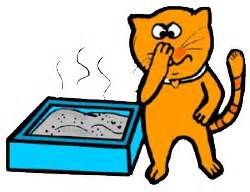 examples of the kind of stressors that might have an effect on your cat’s bowel habits. Stress also causes inflammation. Irritable bowel syndrome is a condition that develops when constant inflammation is present. In order to reduce the inflammation the stressors have to be eliminated. The diet has to be addressed to eliminate any aspects that will contribute to the inflammation as well.
examples of the kind of stressors that might have an effect on your cat’s bowel habits. Stress also causes inflammation. Irritable bowel syndrome is a condition that develops when constant inflammation is present. In order to reduce the inflammation the stressors have to be eliminated. The diet has to be addressed to eliminate any aspects that will contribute to the inflammation as well.
In my experience, cats that are fed a raw food diet rarely have digestive issues. Supplements like slippery elm or marshmallow root help soothe the lining of the intestinal tract to help it heal. Probiotics are also very beneficial. They help to repopulate the micro flora in the intestines so the cat can process its food more efficiently. By addressing all aspects of your cats lifestyle and making changes where needed can help to eliminate the horrible experience of your cat’s intestinal distress.
Until next time my Furry Followers!
Welcome to Amy’s Animals Family!
 Hello! We’re Amy & Rich Fiumarelli, and we would like to welcome you to our Amy’s Animals family, where we really care about the health of your pet. We work hard to make sure that we can provide you with everything you need to keep your pet in tip top shape! I’m not only talking about the products we sell.
Hello! We’re Amy & Rich Fiumarelli, and we would like to welcome you to our Amy’s Animals family, where we really care about the health of your pet. We work hard to make sure that we can provide you with everything you need to keep your pet in tip top shape! I’m not only talking about the products we sell.  I’m talking about the information we can share with you about any new research findings, medical or wellness tips, or other tidbits that we’ve picked up in the 20 years I’ve been in the pet industry. All the information we provide is based on proven, factual research and also on anecdotal evidence. We have a passion for helping you learn everything you ever wondered about regarding your pet.
I’m talking about the information we can share with you about any new research findings, medical or wellness tips, or other tidbits that we’ve picked up in the 20 years I’ve been in the pet industry. All the information we provide is based on proven, factual research and also on anecdotal evidence. We have a passion for helping you learn everything you ever wondered about regarding your pet.
Check out our facebook page, Amy’s Animals Holistic Nutrition Center, our website, Amy’s Pet Nutrition Center, and my blog, Amy’s Animals Holistic Canine & Feline Nutrition Center for plenty of great information and some fun pet articles! Also, sign-up to receive our email news..keep in the know, by being part of the Amy’s Animals Family. Join our Furry Followers and have a picture of your pet posted on our website! You’ll also meet our little pack. Clyde, our boxer, his chi-bee brothers Ollie, Ernie & Tyler and sister Ellie Crumbles. Be sure to check us out regularly. There is always something happening at Amy’s Animals!
Dogs…Wolves that live in your house!
 Dogs are not far removed from their wild ancestors. They share 99% of their mitochondrial DNA with the wolf. Some people argue that domestication has changed their physiology enough that they are now not made to eat the same diet as that of the wolf.
Dogs are not far removed from their wild ancestors. They share 99% of their mitochondrial DNA with the wolf. Some people argue that domestication has changed their physiology enough that they are now not made to eat the same diet as that of the wolf.
Evolutionary changes in species take hundreds of 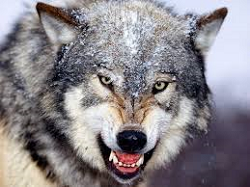 thousands of years, if not longer. Studies of remains found in caves throughout the world have shown that the oldest traces of dogs were approximately 30,000 years ago. Even with the studies of those remains it is not known exactly what part the dog played in the interaction with humans. Were they companions? Were they simply scavengers? Or were they used as a food source themselves? One thing we do know is that upon examination of the domestic dog today, science has concluded that the domestic dog’s nutritional needs are the same as that of the wolf. A high meat protein, low carbohydrate diet is the ideal diet for most dogs. By feeding a diet that more closely resembles a dog’s natural diet you will notice many improvements in your dog such as, less shedding, shinier coat, cleaner teeth, less “doggie” smell and best of all, less poop!
thousands of years, if not longer. Studies of remains found in caves throughout the world have shown that the oldest traces of dogs were approximately 30,000 years ago. Even with the studies of those remains it is not known exactly what part the dog played in the interaction with humans. Were they companions? Were they simply scavengers? Or were they used as a food source themselves? One thing we do know is that upon examination of the domestic dog today, science has concluded that the domestic dog’s nutritional needs are the same as that of the wolf. A high meat protein, low carbohydrate diet is the ideal diet for most dogs. By feeding a diet that more closely resembles a dog’s natural diet you will notice many improvements in your dog such as, less shedding, shinier coat, cleaner teeth, less “doggie” smell and best of all, less poop!
I advise people to feed the best food you can afford. By spending more on your dog’s food, you will have a much healthier dog. You will also lessen the chances of your dog developing some of the diet related health issues such as, skin conditions, hot spots & obesity to name a few.
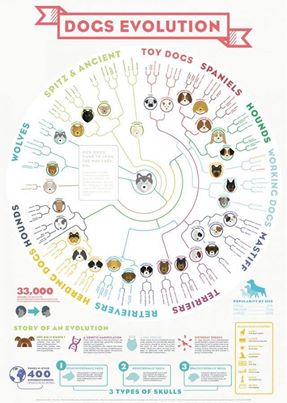 All inclusive frozen raw meat diets make it very easy to feed your dog the best nutritionally packed meal as possible. Grain free dehydrated and grain free kibbled diets are also great choices. For small dogs, grain free dehydrated or grain free canned foods are affordable and convenient.
All inclusive frozen raw meat diets make it very easy to feed your dog the best nutritionally packed meal as possible. Grain free dehydrated and grain free kibbled diets are also great choices. For small dogs, grain free dehydrated or grain free canned foods are affordable and convenient.
If you are going to choose a dry kibble or canned diet be sure to read the ingredients list. The first couple of ingredients on the list should be meat. Wheat, Corn & Soy should be avoided. No high quality dog food contains these grains. Artificial colors, flavors & preservatives should also be avoided. In the pet food market you truly do get what you pay for. Meat is much more expensive than grain, so a higher meat protein dog food will cost more than a poor quality grain based food. But remember, the higher the quality food, the healthier your dog is going to be!
The same rules apply to the treats you give to your dog. Read the ingredients. Avoid any brightly colored treats. Avoid any treats that look like Play-Doh! These treats are FILLED with chemicals that contribute to poor health. Choose meat based treats whenever possible. You can also use frozen or fresh vegetables and fruits such as: Green beans, broccoli florets, Asparagus spears, baby carrots, peas, blueberries, raspberries, all make great all natural healthy treats. Meat that is cut into little cubes, frozen individually on a cookie sheet and stored in a bag in the freezer also make great treats. Dogs love them!! Just make sure to size them appropriately for your dog.
This is a list of some of the ingredients to AVOID when shopping for food and treats: meat & bone meal, sugar, chicken by products or meal, sorbitol, corn syrup, poultry by products or meal, meat by products or meal, beef & bone meal, peanut hulls soybean mill run, wheat middlings, bha or, wheat, hydrochloric acid, ethoxyquin, ground yellow corn, corn gluten meal chicken liver digest corn meal, wheat gluten, soy flour, wheat flour soybean meal, animal fat, animal digest, corn, beef tallow, propylene glycol, ground wheat, and soy.
So remember, don’t let the front of the package fool you! Turn it around and read the back. Your dog can’t shop for himself so he is relying on you to choose a diet that is going to keep him happy and healthy for years to come! Happy Shopping!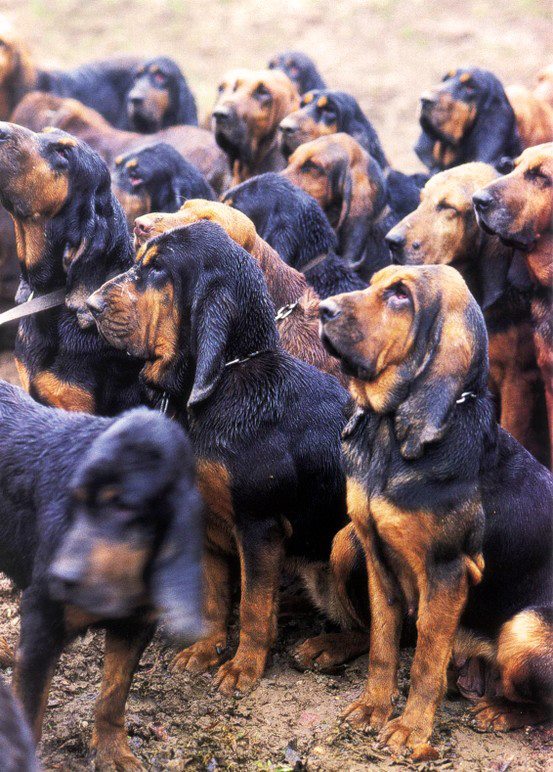
Cats..The lion lurking in the living room!
 Although cats have been domesticated for thousands of years, their nutritional needs have not changed at all. Cats are obligate carnivores. They are meant to only eat meat. In their natural environment, cats will get most of their moisture from their food source. Since they are descended from desert dwellers, they do not have the instinct to drink. They will never drink enough water to satisfy their hydration needs. If they do not get adequate moisture in their food they will live out their lives partially dehydrated. This eventually leads to the common health problems we see in cats such as urinary tract disease and kidney disease. Since they are true obligate carnivores, cats will not voluntarily eat carbohydrates. When they catch prey, they eat all but the intestinal system of that prey. This would be the only source of carbohydrates the cat would be presented with. A mouse in a can would be the ideal diet for a cat! Think of the lions and tigers you see in Africa. They are not sitting around a huge bowl of dry kibble! They are hunting and eating prey animals. These prey animals offer all the nutrition the cat needs.
Although cats have been domesticated for thousands of years, their nutritional needs have not changed at all. Cats are obligate carnivores. They are meant to only eat meat. In their natural environment, cats will get most of their moisture from their food source. Since they are descended from desert dwellers, they do not have the instinct to drink. They will never drink enough water to satisfy their hydration needs. If they do not get adequate moisture in their food they will live out their lives partially dehydrated. This eventually leads to the common health problems we see in cats such as urinary tract disease and kidney disease. Since they are true obligate carnivores, cats will not voluntarily eat carbohydrates. When they catch prey, they eat all but the intestinal system of that prey. This would be the only source of carbohydrates the cat would be presented with. A mouse in a can would be the ideal diet for a cat! Think of the lions and tigers you see in Africa. They are not sitting around a huge bowl of dry kibble! They are hunting and eating prey animals. These prey animals offer all the nutrition the cat needs.
Meat for protein, bones for calcium, organs for fat, blood for micronutrients and 78-80% moisture content! The cat that prowls around your living room needs the same type of diet! Knowing now what the ideal diet for a cat really is, try to buy the closest to this diet that you can find.
 Raw frozen diets are now available. Just thaw it and feed your cat twice a day. The next best alternative is grain free dehydrated food. Just add water and feed twice a day. The third choice is canned food. Also feed twice a day. Grain free dry food is the last alternative as it doesn’t contain enough moisture for the cat to thrive, but it is a better alternative than a carbohydrate based kibbled food. There is now a starch free kibble food available that would be the ideal choice if choosing a kibble. Even though most cat owners like to leave food out all day for their cats, this is not the best choice. Cats should not be fed free choice. They are not meant to graze. They benefit from the fasting period between meals. In the wild, they only ate if they had a successful hunt. If they didn’t, they would fast, sometimes for days. This allows the cats body to use its
Raw frozen diets are now available. Just thaw it and feed your cat twice a day. The next best alternative is grain free dehydrated food. Just add water and feed twice a day. The third choice is canned food. Also feed twice a day. Grain free dry food is the last alternative as it doesn’t contain enough moisture for the cat to thrive, but it is a better alternative than a carbohydrate based kibbled food. There is now a starch free kibble food available that would be the ideal choice if choosing a kibble. Even though most cat owners like to leave food out all day for their cats, this is not the best choice. Cats should not be fed free choice. They are not meant to graze. They benefit from the fasting period between meals. In the wild, they only ate if they had a successful hunt. If they didn’t, they would fast, sometimes for days. This allows the cats body to use its 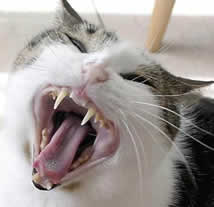 energy in areas other than digestion.
energy in areas other than digestion.
For male cats, this is especially important. One study has shown that just in the presence of food, alkaline is directly released into the urinary system of the cat. In male cats this makes them more susceptible to urinary tract disease. By feeding the cat and then removing the bowl this risk is eliminated. The cat foods available in the supermarket are usually high carbohydrate based foods. Grain is much cheaper than meat. The manufacturers add flavor enhancer’s to them to make them palatable to the cat. Remember, cats won’t voluntarily eat carbohydrates. Read the ingredient label. If the product has wheat, corn or soy in it, don’t buy it. If it has by-products in it, don’t buy it. These ingredients are very poor quality and very hard for the cats body to digest and process. This puts unnecessary strain on the organs of the cat which eventually will cause health problems.
The same rules apply when picking out treats for your cat. Better choices for treats include freeze dried meat or freeze dried fish. By feeding a more species appropriate diet to your cat you will be assured that you will keep your cat happy & healthy for years to come!

